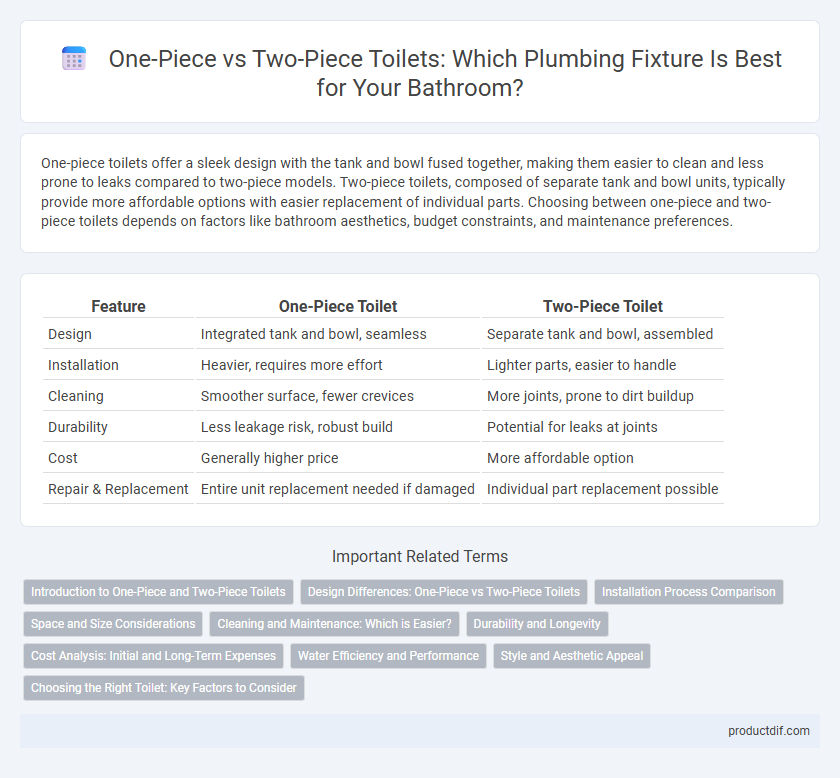One-piece toilets offer a sleek design with the tank and bowl fused together, making them easier to clean and less prone to leaks compared to two-piece models. Two-piece toilets, composed of separate tank and bowl units, typically provide more affordable options with easier replacement of individual parts. Choosing between one-piece and two-piece toilets depends on factors like bathroom aesthetics, budget constraints, and maintenance preferences.
Table of Comparison
| Feature | One-Piece Toilet | Two-Piece Toilet |
|---|---|---|
| Design | Integrated tank and bowl, seamless | Separate tank and bowl, assembled |
| Installation | Heavier, requires more effort | Lighter parts, easier to handle |
| Cleaning | Smoother surface, fewer crevices | More joints, prone to dirt buildup |
| Durability | Less leakage risk, robust build | Potential for leaks at joints |
| Cost | Generally higher price | More affordable option |
| Repair & Replacement | Entire unit replacement needed if damaged | Individual part replacement possible |
Introduction to One-Piece and Two-Piece Toilets
One-piece toilets feature a seamless design where the tank and bowl are integrated into a single unit, offering a sleek appearance and easier cleaning. Two-piece toilets consist of a separate tank and bowl, making them generally more affordable and easier to transport or repair. Both types vary in installation complexity, durability, and space efficiency, influencing homeowner preferences and bathroom layouts.
Design Differences: One-Piece vs Two-Piece Toilets
One-piece toilets feature a seamless design where the tank and bowl are molded together, resulting in a sleeker appearance and easier cleaning due to fewer crevices. Two-piece toilets consist of a separate tank and bowl joined by bolts, allowing for easier transportation and replacement of individual parts. The unified design of one-piece toilets tends to consume less space, making them ideal for compact bathrooms.
Installation Process Comparison
One-piece toilets simplify the installation process due to their integrated design, reducing the number of components to align and seal, which minimizes potential leak points. Two-piece toilets require assembling the tank and bowl separately, necessitating careful alignment and secure tightening of bolts to prevent leaks and ensure stability. Professional installation time for one-piece units averages 1-2 hours, while two-piece units may take 2-3 hours due to additional assembly steps.
Space and Size Considerations
One-piece toilets feature a compact design that saves significant space, making them ideal for small bathrooms or tight quarters. Two-piece toilets generally require more room due to the separate tank and bowl components, which can limit placement options. Measuring the available bathroom area and considering door swings is crucial when choosing between one-piece and two-piece toilets to optimize space efficiency.
Cleaning and Maintenance: Which is Easier?
One-piece toilets offer easier cleaning and maintenance due to their seamless design, which eliminates crevices where dirt and bacteria can accumulate. Two-piece toilets have a separate tank and bowl, creating joints that require more effort to clean and maintain. The integrated construction of one-piece models reduces the risk of leaks and simplifies repairs compared to two-piece toilets.
Durability and Longevity
One-piece toilets offer superior durability due to their seamless design, reducing leaks and cracks commonly found in two-piece models. The fused construction enhances longevity by eliminating the weak points where the tank and bowl connect, resulting in fewer maintenance issues over time. Two-piece toilets, while often easier to transport and install, typically present more wear at the joints, which can compromise their lifespan compared to one-piece fixtures.
Cost Analysis: Initial and Long-Term Expenses
One-piece toilets typically have a higher initial cost due to their integrated design and ease of installation, while two-piece toilets are generally more affordable upfront but may require more maintenance over time. Long-term expenses for one-piece models are often lower because of fewer leaks and easier cleaning, reducing repair and replacement costs. Two-piece toilets might incur additional costs from seal failure or broken connections, impacting overall lifetime affordability.
Water Efficiency and Performance
One-piece toilets typically offer enhanced water efficiency due to their seamless design, reducing potential leaks and improving flush performance with optimized trapways. Two-piece toilets may have slightly lower water efficiency as the separate tank and bowl connections can cause minor water loss over time. Performance-wise, one-piece models often provide stronger, quieter flushes, while two-piece toilets are valued for easier maintenance and replacement parts.
Style and Aesthetic Appeal
One-piece toilets feature a sleek, seamless design that enhances modern bathroom aesthetics and simplifies cleaning by eliminating crevices between the tank and bowl. Two-piece toilets offer a classic, traditional look with a visible joint between the tank and bowl, which can complement vintage or farmhouse-style bathrooms. The choice between one-piece and two-piece toilets significantly impacts the overall visual harmony and design style of the bathroom space.
Choosing the Right Toilet: Key Factors to Consider
One-piece toilets offer a sleek design with easier cleaning and fewer crevices, making them ideal for modern bathrooms with space constraints. Two-piece toilets provide greater flexibility in installation and are typically more affordable, suited for larger bathrooms or budget-conscious projects. Key factors to consider include bathroom size, budget, maintenance preferences, and installation complexity.
One-piece toilet vs Two-piece toilet Infographic

 productdif.com
productdif.com